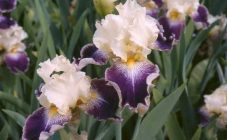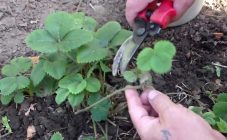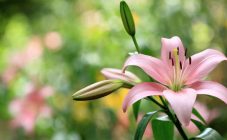Content:
The majestic lily has won the hearts of many summer residents and gardeners. Caring for these flowers is not difficult, but there are nuances that you should pay attention to. The key to a lush and abundant flowering of lilies is correct and timely pruning.
General rules for caring for lilies
Lilies belong to the Liliaceae family. These are bulbous plants. And in many respects the appearance of this flower depends on the quality of the bulb.
It will not be difficult to grow a beautiful, lush lily. She prefers morning sunlight, fertile, slightly moist soil with a large humus layer. Therefore, for her, you should choose a place where the sun hits in the morning. With a lack of light, these flowers will stretch into growth, that is, the development of the stem, and not the buds, will take place.
Lilies do not like acidic soil. Depending on the variety, they require a neutral or slightly acidic environment. Throughout their development, these flowers, like other garden plants, require feeding. Lilies respond well to mineral fertilizers. At the first stage of development, fertilizers are needed, which include nitrogen. And starting from the budding period, potash and phosphorus fertilizers should be applied to the soil.
When to prune lilies
Many amateur gardeners do not know when to harvest lilies, so they completely cut off their stems immediately after flowering, that is, as soon as the petals fall off. They do not even suspect that they are causing irreparable harm to their favorites.
After flowering in stems and leaves, the process of photosynthesis continues. Nutrients continue to flow through both the roots and the ground parts of the plant. With premature pruning of the stems, the bulb will no longer receive some of the nutrients. As a result, there may be a slowdown in its growth, up to a complete stop. Thus, the bulb may not grow to the size required for successful flower stalks the following year.
In the first year after planting, lilies have a small bulb. For those who want the young lily to gain strength and delight the grower with luxurious large flowers for the next season, it is advisable to cut off all the buds. In this case, she will receive more nutrients that are so necessary for her in the first year of life.
In subsequent years, the bulb will already be acclimatized to soil conditions and there will be no need to cut the buds during flowering. When to cut the flower stalks of a lily in this case? After flowering, the petals gradually fall off by themselves and only the seed capsule remains on the stem. Then it is necessary to cut the peduncle. This trimming is required. If you do not remove the seed capsule, all incoming nutrients will go to the development of the seeds, and not to the development of the bulb. It will also negatively affect future flowering.
Pruning lilies into a bouquet
Lily bouquets look luxurious and sophisticated. Is it possible to cut flowering lilies into a bouquet without harming the bulb? Naturally, yes, but for this you need to pay attention to some nuances:
- For bouquets, you should choose flowers that have 5 or more buds. This is a sign that the bulb has already reached a sufficient size for further development.
- When cutting lilies, it is necessary to ensure that the stem remains at least 20 cm high from the ground. Thus, the supply of nutrients to the bulb will not stop.
- The cut should be done at a slight angle with a sharp pruner. This will prevent rainwater from getting inside the stem and the bulb will not rot.
- The cut site should be treated with wood ash for quick healing. This will help avoid stem rot, as well as disease of the entire plant.
High odor pruning
Lilies have a specific, pungent aroma. Not everyone likes this smell. It is especially not to the liking of people prone to allergies. Do I need to cut the lilies during flowering in this case? After all, the deadline for cutting the buds has not yet come, and it is a pity to remove the flowers at the very beginning of flowering.
The lily scent is formed from the volatile oils given off by all terrestrial parts of the plant. The biggest source of odor is the pollen that accumulates on the stamen. Removing it, rather than the entire stem, will help weaken the scent. To do this, you need to bring a paper bag to the bud and carefully cut off the stamens from it. This procedure should be repeated with each blooming flower.
After removing the stamen, the lily scent will remain, but it will be subtle and unobtrusive.
Pruning stems and leaves
Plants should be inspected as often as possible for diseased or damaged tops. If found, they must be removed, regardless of the stage of development. It is impossible to completely cut off all the tops; you should leave as many green and healthy leaves as possible.
In some cases, you will have to completely remove the plant:
- If the foliage is covered with specks (spots). This means that the lily got sick with mosaic - a viral disease.
- If the bulb or roots are rotten.
How to properly prune a plant for the winter
How to prune lilies in the fall? It has already been said above that one cannot prematurely cut off the ground part. After flowering in the foliage and stems, life continues: under the influence of sunlight, chlorophyll is formed in the leaves, which oxygenates the bulb. Therefore, immediately after the end of flowering, the stems and leaves are not removed. They should be removed only after complete drying.
Unlike daylilies, in which the stem is cut at the root, part of the stem is left in lilies. The optimal length to be left to the ground is 10-15 cm. Pruning is carried out with a sharp disinfected knife or pruning shears. You must use the tool carefully so as not to cut yourself.
For the winter, the area with lilies must be insulated. Fallen leaves are perfect for this. It is not recommended to cover with sawdust, as they tend to freeze.
How to prune flowers before transplanting
Lilies in one place can grow up to 3-5 years. The bulb of this plant quickly produces babies, as a result of which the flowers become smaller. Then it is time to prune and replant lilies.
There are two transplant options: in spring or autumn. If further planting is scheduled for spring, the stems should be cut after wilting, leaving 10-15 cm from the ground. This is about a month after full flowering. Cut off the remainder before digging out. It is necessary to dig up the bulb in September-October, as late as possible after flowering.
The best time for transplanting is autumn.In this case, you need to cut off the stems at ground level, and dig up the bulbs a month after the plant withers. Then, within 1-2 days, dry the bulbs, clean them of dry scales, disinfect them in a weak solution of potassium permanganate and plant them in pre-prepared soil.
Pruning indoor lilies
Indoor varieties go through the same stages of development as lilies grown outdoors: they fade, gradually dry out, and pass into a dormant state. Should I prune indoor lilies or leave the top to die off naturally?
To bloom next year, the bulb needs to rest and accumulate nutrients. Therefore, if the indoor lily has faded, you cannot immediately cut off its stems. At first, only the peduncle should be cut. Next, you need to reduce the supply of moisture, while simultaneously extending the interval between waterings, and stop spraying. This will accelerate the accumulation of nutrients in the bulb. The stem is cut off only after its complete drying.
Tips and tricks from experienced florists
Lilies are a fairly common garden flower. And many summer residents have their own secrets of pruning this plant. Some of them are listed below:
- In order for the appearance of withering stems not to spoil the overall picture of the garden plot, it is necessary to plant annual plants with lilies, the flowering period of which coincides with the period of drying of the foliage. Planting ornamental tall grass is also a good solution.
- In order not to darken the view of the flower bed, it is advised to do a gradual pruning, i.e. prune the stem weekly as it dries.
- Some growers consider it unnecessary to prune the lily stem in autumn and leave it until spring.
Lilies are quite unpretentious garden plants to care for. Now, knowing when to cut lilies, it will not be difficult to grow a healthy bulb that will bloom with amazing, luxurious flowers every year.
















